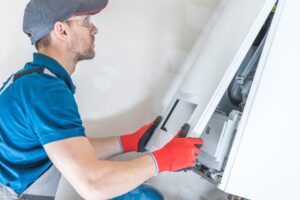Your furnace has sensors in it to help with various functions. One of them is on your blower motor, which is what pushes air throughout your ductwork and out of your vents. Without it, the whole system simply doesn’t work as it’s supposed to.
Throughout all the furnaces in Lebanon, OH we’ve serviced or we’ve seen, on more than one occasion, the sensor on a furnace’s blower motor give out. This doesn’t sound like much of a big deal, but it actually has some serious ramifications for how your furnace runs. Let’s take a look at just what it does, and what it can do when it goes out.
Here’s What Your Blower Motor Sensor Does
Your blower motor pushes warm air throughout your ductwork and then it spills out of your vents. But your blower motor doesn’t push at 100% force, and it does that for a reason.
If it blows air too fast, it can actually cool the warm air that your furnace just produced. Sounds a bit counterintuitive, doesn’t it? The sensor on your blower motor controls the flow of air by either allowing or resisting a certain level of power to the motor.
Known as a resistor for obvious reasons, this sensor is designed to keep your blower motor fan in check. So when it stops functioning, it won’t resist electricity, and your blower motor fan will just go crazy, cooling the warm air you just spent money on before it makes it to your vents. While it won’t cool it completely, it makes it take longer to heat your home in the first place.
It Can Overheat and Burn Out
Let’s say your blower motor keeps going at max capacity for a while. Just because it can doesn’t mean that it should and that excessive use will wear it down faster. It can and eventually will burn out prematurely, leaving you with no way to deliver warm air throughout your entire home.
Your Furnace Can Actually Overheat
If your blower motor hits the point where it breaks down completely, then you’ll know because there will be absolutely zero airflow coming out of your vents. If you hold your hand up to your vent, it won’t produce any force or breeze. That means all that warm air just sits in your furnace, building up the heat over time, and it can actually make your furnace overheat.
It sounds silly to even think about a furnace overheating, but it can. When this happens, it shuts down as a failsafe, leaving you confused as to why it ran for so long and still didn’t heat up your home. Or, it will never receive that “OFF” signal from your thermostat, keep running, and cost you a lot of money. Either way, we want to avoid both of those scenarios.
Get it Fixed ASAP
Whether it’s this or another problem, it’s important to get your furnace fixed as soon as possible. Let’s take a look at your furnace and see if it’s what the problem is, and get it taken care of so you can get back to enjoying your comfort. All it takes is a phone call to get started.
Contact JM Mechanical Heating & Cooling today to schedule your furnace repair or replacement as soon as possible.

